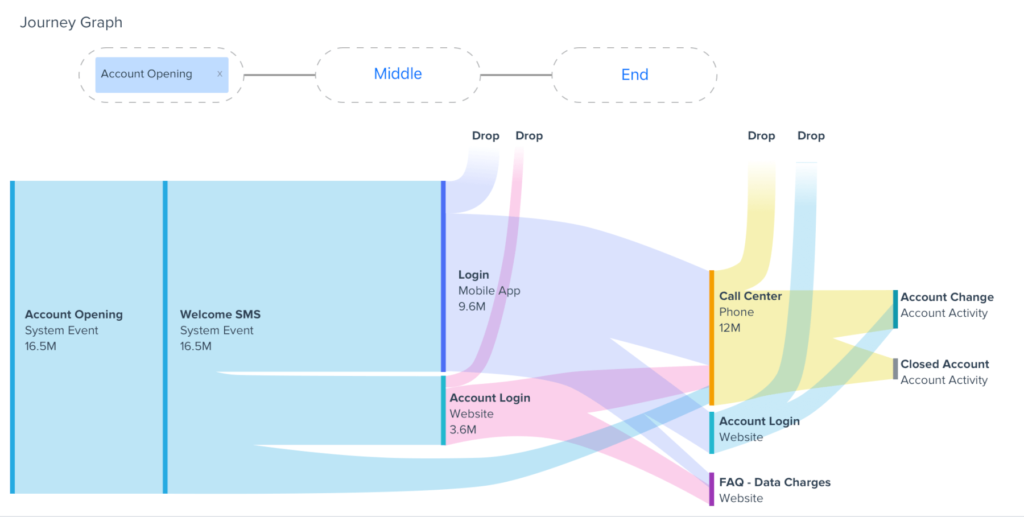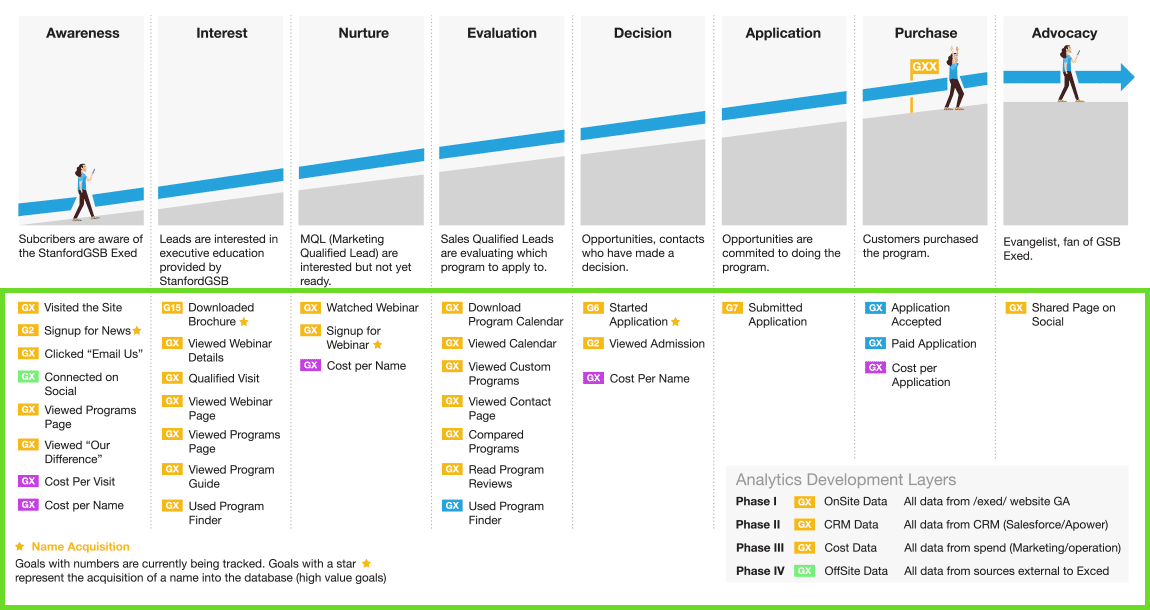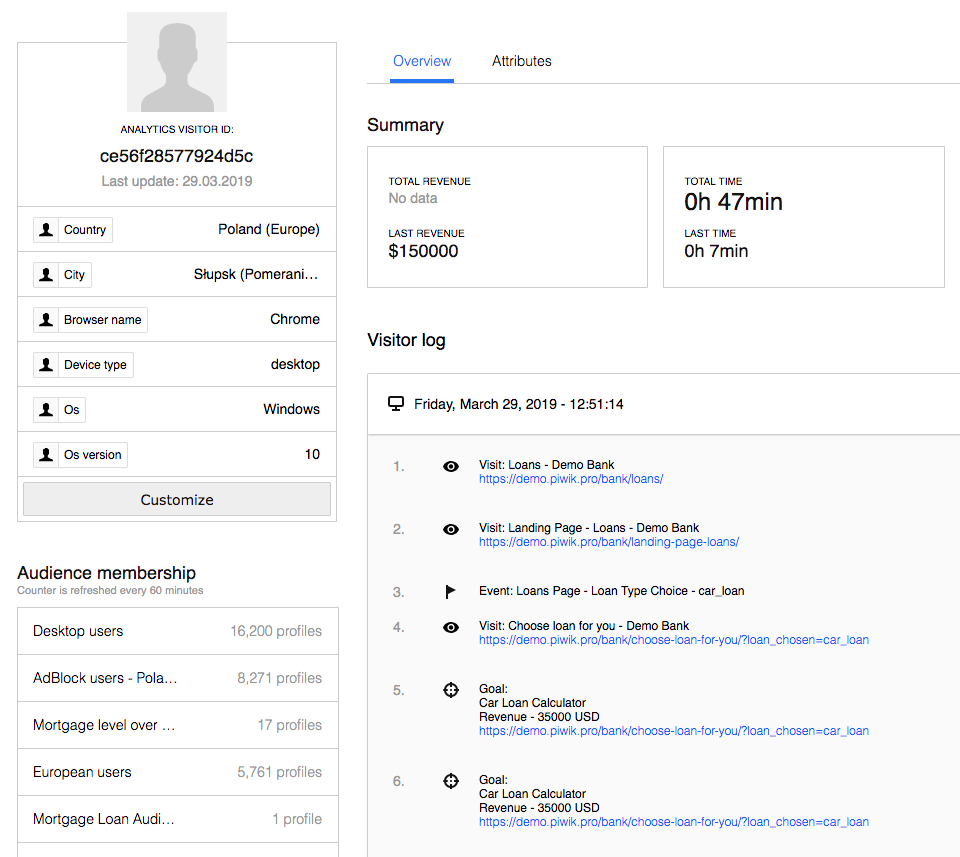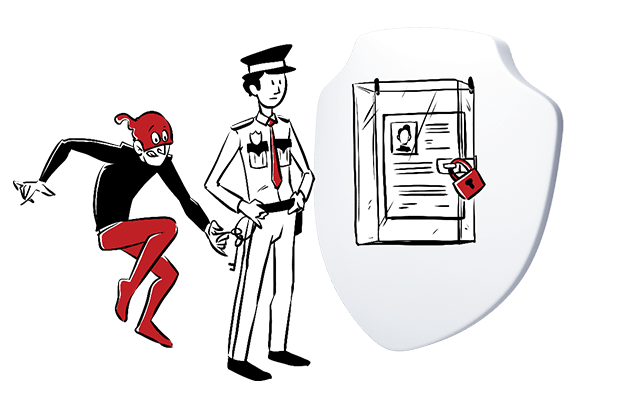This blog post was originally published on July 23rd, 2019 with the title “How customer journey analytics will change the way you look at customer experience optimization”
Businesses turn to customer journey analytics to create a consistent buyer’s journey, outperform competitors, and boost revenue.
Customer journey analytics helps you connect all the dots of a fragmented customer journey, locked in silos within your organization. This leads to a better understanding of your customers and allows you to tailor the services you offer to their preferences and expectations and improve their experience with your company.
In today’s article, we’ll walk you through the ins and outs of customer journey analytics and show you what benefits it brings to your business.
What is customer journey analytics?
According to Gartner, customer journey analytics is “the process of tracking and analyzing the way customers use combinations of channels to interact with an organization.”
It’s about merging information collected from different sources to gain a detailed perspective on customers. Customer journey analytics is a dynamic process. Your analytics platform constantly gathers, updates and organizes data to show you the exact how/what/why/when of customer behavior.
One of the key advantages of customer journey analytics is that it works on precise data. It merges information from many sources and includes direct input from consumers. The collected data consists of consumers’ interactions with companies via different touchpoints and channels. It shows how these actions relate to each other and what effect each interaction has on your customers’ decisions.
Customer journey analytics is a tool you can use to address and resolve any pain points that prevent users from taking desired actions. You can connect the dots between customer behavior and the KPIs your business uses, and learn how to improve user experience.
Crucially, conversion isn’t the only goal of an effective journey. You want to analyze the actions taken before and after making a purchase or signing a contract:

pro tip
Customer journey analytics is versatile. You can apply it to recruitment processes, app or product engagement, recovering carts, and more.
How customer journey analytics works
Let’s start with breaking down the process of customer journey analytics into smaller steps to understand this concept.
Step 1. Collect customer data
You receive customers’ information throughout their relationship with your business, both online and offline. Then it sits in your CRMs, analytics, emails, etc. The data tells you which channels lead consumers to your website, what content they browse, or even which store they visit most often.
Step 2. Connect the dots about users
By merging your customers’ data, you’ll be able to create profiles to understand who they are and grasp their expectations and preferences. Later, you’ll enrich those profiles with new details whenever consumers contact your organization.
Step 3. Analyze the data
Once the data is organized, you start analyzing it. This is where an advanced analytics platform with data tools comes in handy. It simplifies the process of spotting trends, patterns and errors. Also, visualized data is faster to understand.
Analyzing data reveals metrics that could otherwise get overlooked. For instance, it makes it possible to:
- see how prospects found your website
- learn how users navigate your site or app
- spot user behavior patterns and bottlenecks in the journey
Step 4. Put your conclusions into practice
The data from your website and app supports you in making informed decisions and designing your strategy to guide customers through their journey. The data provides you with clues on actions you should take to revamp your website, optimize the signup or payment process, and add more engaging content.
Before we move on to performing the analysis, we’ll explain one concept that frequently appears in this context: customer journey mapping.
What is customer journey mapping?
We’ve explained what customer journey analytics is, but how does it relate to customer journey mapping? Both are useful, but they aren’t the same thing. Here’s why.
You can apply customer journey mapping to plan and visualize individuals’ experiences on your site or app. However, it won’t provide you with the details you need to run in-depth analyses.
The trouble with those maps is that they’re created by marketing teams and lack customers’ input. They only imitate journeys and tend to represent ideal paths businesses want to achieve rather than the real routes people take.
What’s more, maps are static. Once created, they might quickly go out of date.
Here’s an example of such a map:

It has a good level of detail and strategic value but shows customers’ “planned” actions.
After you’ve built this journey map, you need to dig deeper. Break it down into segments that correspond with different phases, which will typically consist of:
- Awareness
- Interest
- Engagement
- Purchase
- Retention
Next, break down each phase further. Identify the essential KPIs you’ll track within each section. Think of it like a checklist of what consumers can accomplish in a given time during their relationship with your organization.
The image below shows you how KPIs can align with different journey phases.

Dividing your journey into smaller chunks and assigning KPIs will lay a solid foundation for performing analyses and establishing analytics goals.
To monitor customer experience KPIs, this map isn’t necessary. However, analysis and visualization of the end-to-end journey are harder without a map to overlay data on.
Marketing teams often send questionnaires to complete information gaps when analyzing journey maps. But surveys lack detail and accuracy. They are usually applied post-purchase, and customers don’t remember every touchpoint they interacted with.
If you’re looking for specific information, such as:
- Created user profile on April 08
- Abandoned shopping cart on April 08
- Clicked on CTA from re-engagement campaign on May 05
- Made first purchase on May 05
you won’t find it in surveys. That’s where customer journey analytics will come in handy.
Benefits of customer journey analytics
1. Better understand your prospects and customers.
Detailed information you gather with journey analytics show you individuals’ needs and pain points. That data helps you adjust your offer to your customers’ preferences, recommend products that solve their problems and create messaging that resonates with them.
2. Remove obstacles and enhance the journey.
Journey analytics enables you to track different trends and zoom in on individual journeys to discover how people connect with your business. This is how you find and remove obstacles that your customers face, for instance in the check-out or onboarding process.
Finally, the collected data will allow you to improve customer support, be it through personalized training or practical self-guides.
3. Refine the metrics you track and rethink your business strategy.
Thanks to customer journey analytics, you obtain detailed information about your channels’ performance so you can evaluate what’s working and what’s not. For instance, by monitoring your conversion funnels you’ll spot the biggest drop-offs. Then, you dig deeper to find the reasons behind those losses.
You also obtain insights like:
- which channels perform best for engagement and lead to sales
- which customer paths result in churn
- what’s the best moment to engage consumers in their journey
- what paths do different audiences take
The data from analytics enables you to review your metrics. Concentrate on those that impact your bottom line, then adapt your marketing strategy as needed.

Read more about Customer Lifetime Value (CLV), a valuable business metric: Customer lifetime value: what it is and why it is important for your business [Updated]
4. Increase marketing ROI.
It’s good to have an analytics platform that lets you connect data from online and offline sources to measure complete journeys. This way you’ll have a bigger picture of which channels and messaging work best and bring the most valuable customers. That allows you to better allocate your marketing budget and focus on initiatives that drive ROI.
5. Make analysis easier.
Even people without extensive data science skills can use analytics platforms, no programming know-how is required. These platforms make it easier to access data compared to retrieving it from standard data warehouses. Plus, visualization options simplify the process of spotting trends, and patterns, and drawing conclusions from the collected information.
6. Discover new micro journeys and KPIs.
As you zoom in on individual journeys, you have a chance to refine existing ones and discover new paths customers take with your business. You’ll recognize more customer behaviors and KPIs you’ve been missing out on. That information put into practice will expand your marketing possibilities and refine your strategy.
How to use customer journey analytics to optimize customer onboarding
In another post on our blog, we discussed how banks could employ analytics to discover how clients are progressing with their onboarding.
The process was broken down into segments, then further into individual actions. Different actions received different score levels depending on the importance of the steps.
As customers moved along their journey, they were earning more and more points. Marketers got a clear overview of where people were in the process and a granular view of the separate interactions that got them their current score.
The bank employed this information to improve customer experience KPIs, such as:
- resolution rate
- average time to resolution
- customer satisfaction
Additionally, a better service increased the likelihood of customer advocacy.
What it takes to make customer journey analytics work
Though customer journey analytics can be used in a variety of scenarios, it’s a complex process, which is why we’ve prepared a list of things to consider when applying it to your work.
Below, we explain what aspects are vital to make customer journey analytics beneficial for your organization. We also describe how you can enhance your customer experience based on the collected information while staying privacy compliant.
1. Flexible analytics platforms
The core of customer journey analytics is the ability to gather, visualize and analyze data. It’s good to rely on an analytics platform that lets you examine what people do on your website, both on desktop or mobile, and inside your app. This piece of software should manage the process of saving and combining data from multiple channels and touchpoints.
Presenting data in the right manner is essential for assessing customer journeys. Analytics platforms offer numerous reports, including custom ones, to display information in a desired way. Here, creating a dashboard can give you a proper view of your website’s performance and allow you to share insights with all stakeholders.
Some platforms also provide integrations with data visualization tools, such as Tableau or Power BI, to advance and speed your analytics processes.
2. Customer data platforms (CDPs)
A customer data platform (CDP) is a great tool that supports customer journey analytics. By assigning unique IDs to your website and app users and applying multiple data sources, such as CRMs, analytics, and transactional systems, the platform builds detailed single customer views (SCVs).
The user profile that you can see below displays:
- country and city
- technology: browser, device type (desktop, mobile, tablet or smart TV), operating system and version
- historical transactions
- visitor log information

Check out our blog post to find out How analytics & customer data platform can help you track the full customer journey.
3. Advanced analytics reporting
Customer journey analytics is complicated, so you need tools that make it simpler while still ensuring accuracy. Let’s find out which reports you’ll rely on the most.
Attribution reports
The customer journey is fragmented as buyers move from one channel and touchpoint to another. That makes the analytics process challenging, especially in terms of conversions. How do you figure out what channel led to the purchase or closing of the deal?
Multi-channel attribution is your go-to method. It’s a process of assigning credit for conversions in the journey that involves multiple channels.
Attribution reports are useful, but they won’t immediately tell you which channel performs best. That’s why it’s best to use these reports to design and run experiments that will bring you lots of indications over time.
It requires a flexible platform that works with a multi-model approach. And if you want to measure conversions for individual customers, you’ll need to gather personal data in a privacy-compliant way. We’ll talk about it in detail later in the article.
Read more about attribution in How to analyze multi-channel attribution in affiliate marketing using raw data.
User flow report
The paths consumers take across your website or application are not linear. It’s key to know:
- which pages the users visited first
- how they arrived there
- what their next step was
- where they left
You can answer those questions with a user flow report.
In this report, it’s possible to pick the key interaction, then see the ones that precede or follow it. This shows you the full path a user takes towards your goal, be it joining a webinar, selling a product or requesting a demo.
Let’s say that the blog on your website links to a home page and posts. Each post has a newsletter signup form. You’d like to figure out how people browse the blog and whether they sign up for an email subscription. The flow report illustrates exactly that.
It allows you to learn whether each step seamlessly leads users to the next, or if some obstacles are blocking them, then address those issues on the spot.

Read more about this topic and get familiar with 3 reports for optimizing user flow on your website
Funnel reports
A significant part of customer journey analytics is studying your conversion funnels. A typical funnel for an ecommerce site can consist of the following steps:
Homepage > Category page > Product page > Cart > Checkout page > Thank you page
But, depending on the industry and characteristics of the business, the funnel steps can vary, making them more elaborate.
A funnel in analytics narrows toward the end – the volume of visitors at the beginning of it is larger than the volume of visitors at the end. Through that, you can get information on where users enter your funnel, how many of them make it to the next steps and where they drop off.
Use funnel reports to perform an analysis of your funnels. They let you define a path you think people take to reach a goal on your site or in your app and you can adjust them based on the length of your sales cycle. With funnel reports, you’ll be able to spot ill-performing touchpoints and measure the efficiency of your page content.
Read more: Funnels based on behavioral segmentation: a little-known way to map the entire customer journey
4. Collecting data in line with privacy regulations
Since optimizing the customer journey analytics requires data, you might find it hard to achieve because of the growing importance of privacy laws. Gathering, processing and transferring data is getting trickier than ever. Just think about the recent uproar around Google Analytics’ violation of the European General Data Protection Regulation (GDPR). So, pay attention to what piece of software you apply for obtaining and sending data.
We explain why you should be careful when using Google Analytics and having to comply with legal requirements in a blog post: Is Google Analytics (3 & 4) GDPR-compliant?
Read more about privacy regulations in:
First, to analyze post-login areas, which often contain personal data, your analytics platform must manage this data appropriately. Such a platform should grant you control over data, flexible hosting options and privacy features, such as opt-in and opt-out.
Second, various privacy regulations like the GDPR and the California Consumer Privacy Act (CCPA), limit the collection and use of personal data. But platforms that offer anonymous tracking will enable you to collect valuable information, even in jurisdictions with stringent privacy laws.
Read more about various analytics tracking options in:
On the other hand, privacy compliance doesn’t have to be an obstacle. It can give you a competitive edge, as it grants you quality data and makes it easier to earn your customers’ trust. And trust is vital for creating solid relationships with them.
You build it when you ask customers or prospects for consent, inform them about processing purposes and explain what happens with their data. Consumers familiar with organizations are more likely to engage and share information with them. Once you obtain consent, new marketing and sales opportunities open up.
With consent, you’re able to utilize customer information for different purposes, whether it’s analytics, conversion tracking or remarketing. Consent lets you gather data from more places, even post-login areas. And since your site and app provide you with granular data, you don’t have to buy it from third parties.

Read more about analyzing the complete journey in: How to capture the whole customer journey when dealing with secure member areas
Finally, getting visitors’ permission gives you peace of mind that you are compliant with privacy regulations, so you can focus on your marketing tasks.
Final thoughts
Getting your customer journey analytics right requires ticking a lot of boxes. That’s why we’ve written this article, and we hope we’ve made it easier to understand the complexity of the subject.
Most importantly, start by looking for a privacy-friendly platform. You’ll be able to collect valuable information and work in line with data protection regulations. Then you can focus on putting your data into action.
If you’d like to know more about analytics platforms and must-have features for your customer journey project, read our articles and comparisons:










